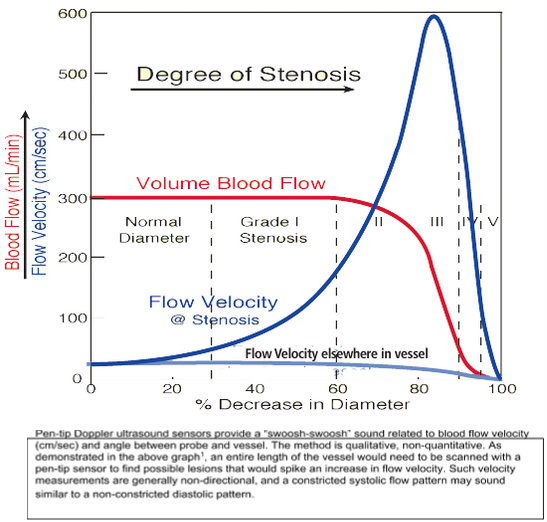Can You Trust Your Fingertip to Feel a Pulse or a Pen-Tip Doppler to Test Bypass Graft Patency?
 Some surgeons ask, “What advantage is there to measuring flow? I am used to palpating the graft to sense flow.” Palpation or feeling a pulse simply indicates that the vessel is connected to the heart. It might give a qualitative indication of the presence of a pulse, but does not detect an occlusion downstream from the point of palpation (i.e., the distal anastomosis). Experienced surgeons may have developed a “feel” for flow by partially occluding the graft and feeling a turbulent thrill to provide a sense that something is passing through the graft. If a partial occlusion exists, the proximal pulse will increase, the distal pulse will decrease. Detecting an arterial obstruction from the pulse is a tenuous art form at best, but may provide the experienced surgeon with qualitative information in cases where the vessel can be palpated. It is quick and inexpensive, but is not quantitative. Flow measurement, on the other hand, provides an unique opportunity to “look inside” the graft and make a quantitative, not qualitative, assessment of graft patency.
Some surgeons ask, “What advantage is there to measuring flow? I am used to palpating the graft to sense flow.” Palpation or feeling a pulse simply indicates that the vessel is connected to the heart. It might give a qualitative indication of the presence of a pulse, but does not detect an occlusion downstream from the point of palpation (i.e., the distal anastomosis). Experienced surgeons may have developed a “feel” for flow by partially occluding the graft and feeling a turbulent thrill to provide a sense that something is passing through the graft. If a partial occlusion exists, the proximal pulse will increase, the distal pulse will decrease. Detecting an arterial obstruction from the pulse is a tenuous art form at best, but may provide the experienced surgeon with qualitative information in cases where the vessel can be palpated. It is quick and inexpensive, but is not quantitative. Flow measurement, on the other hand, provides an unique opportunity to “look inside” the graft and make a quantitative, not qualitative, assessment of graft patency.

In contrast, pen-tip Doppler instruments offer quantitative measurements. They measure velocity. Velocity is a vector associated with movement alone and is expressed in units of distance per time (cm/sec, miles/hour). Velocity is most sensitive to a misalignment between a vessel and a sensor. Measuring the average velocity is complicated by the parabolic profile of laminar flow across a vessel in which blood flows faster in the center of a vessel than along its sides. To accurately measure flow from flow velocity, a sensor must be able to integrate measurements over the entire area of the vessel. In practice, many velocity sensors only measure the maximum velocity at the center of a vessel and assume a parabolic laminar profile. Other sensors measure the local velocity at several points and assume a rotationally symmetric profile. Although pen-tip Doppler flow measurements are less costly than transit-time ultrasound measurements, Doppler velocity has much lower diagnostic accuracy and precision.
Flowsensors measure volume flow. Flow, like pressure, is a vector, but is the movement of mass expressed as units of mass (mL/min, L/min). Flow volume is the product of average velocity and area. Since both terms are vectors, the velocity term must actually be the component of velocity perpendicular to the plane of the area. In hemodynamic applications, both area and velocity are constantly changing. Therefore, volume flowsensors, such as transit-time ultrasound Flowprobes, are usually integrating devices that respond to changes in local velocity over the entire area of the vessel. A perfect volume flowsensor is uniformly sensitive to changes in velocity over the entire cross-sectional area of the vessel, and is fully insensitive to changes in the cross-sectional area of the vessel.
In summary, detecting pulse with one’s fingertips is qualitative as best. Doppler velocity sensors measure localized velocity in a vessel. However, by integrating changes in velocity over the entire cross- sectional area of a vessel, transit-time ultrasound Flowprobes provide a true measure of volume flow that will accurately confirm the patency of a bypass graft. If it is worth taking your time to construct a graft, then it is also worth your time to measure flow in that graft to ensure the best outcome for your patient.
Image Source: From Spencer P, Reid, J.M, “Quantification of Carotid Stenosis with Continuous-Wave (C-W) Doppler Ultrasound,” Stroke 1979; 10(3) 326-330.




